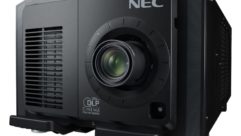Projector Light Engines
Nov 1, 2000 12:00 PM,
Peter H. Putman
High brightness video/data projectors are among the hottest AV products on the market. They’re found everywhere from concert venues to theatres to large stadiums, projecting data, graphics, video, and image magnification. This explosive growth has been driven by the availability of flat-screen, high brightness imaging technologies, combining plug-and-play operation with metal-halide and xenon projection lamps.
At the heart of many projectors, you’ll find an all-digital imaging system that was originally developed for laser printers. It’s called Digital Light Processing[TM], and it produces bright, high contrast video and computer images by modulating reflected light from a mirrored surface back through a projector’s lens and onto the screen.
The amount of light reflected from one mirror to the next also creates a grayscale image, which becomes more apparent as the number of mirrors increases. By moving the mirrors quickly enough, video, HDTV, and high resolution graphics can be displayed.
1 + 0 = video??The small semiconductor that performs this job is called a Digital Micromirror Device[TM], or DMD. DMDs are actually small arrays of tiny mirrors, resting on a static RAM chip. Each mirror can tilt a maximum of 10ø, responding to a digital “1” (on) or “0” (off) command from the RAM chip.
A mirror fully tilted in the “1,” or on, position reflects the maximum amount of light, while the “0,” or off, position results in no reflection. Grayscale images are created only when each mirror cycles rapidly between the “1” and “0” states, using a technique known as digital pulse-width modulation (PWM).
This transition from “1” to “0” is extremely fast, cycling in less than 15 milliseconds. If an individual mirror is on more than off within a given time interval, the reflected light from that mirror will appear brighter. If it’s off more than on, the reflected light will appear darker. DMDs are quite efficient, reflecting 60% of the light that strikes their surfaces.
By itself, a DMD is a grayscale (black-and-white) device, incapable of reproducing anything other than grayscale images. There are two ways that color can be added to DMDs: using a color wheel, or employing three separate DMDs to modulate red, green, and blue light, which is then combined in a prism.
The color wheel method has the advantage of being a very small system. The wheel rotates at very fast speeds – fast enough to reproduce video – and its presence in a projector can be detected by waving your fingers in front of the lens. You’ll see a rainbow-like effect, especially with bright white images. The movement of this wheel is precisely synchronized to the operation of the DMD chip. When a specific color with a specific grayscale value is required, that section of the wheel will be positioned in front of the DMD.
Separate passes are required for red, green, and blue, a process that sounds like it should take a lot longer. However, thanks to persistence of vision in the human eye, we don’t notice these stepped changes, only a continuously colored image.
The color wheel has its advantages and disadvantages. The obvious advantage is the small size of single-chip DLP projectors, which is currently under 3lbs and less than 2″ thick! The principal disadvantage is the limited color saturation possible, and the tendency of some people to notice the strobing “rainbow” effect when they blink.
If size isn’t a consideration, but high quality color mixing is required, then a three-chip system is called for. Light from the projector lamp is split into its red, green, and blue components by a series of dichroic mirrors. Each path of colored light is then focused on a separate DMD chip. The reflected images from each of these chips are then recombined in a prism, focused, and projected through a single lens.
While the three-chip color process provides the most lifelike color imaging, it also requires the largest optical engine, and is used primarily in high brightness, large-venue projectors. Because separate red, green, and blue filters are used, it’s possible to calibrate a DLP projector to a wide range of color temperatures and white points required for electronic cinema, image magnification, and other applications where color rendering must be precise.
Resolution & aspect ratiosLike other flat-matrix imaging technologies (LCD and plasma), DMDs have a fixed pixel resolution whether on or off. Eight-hundred-forty-eight by 600-pixel (SVGA) DMDs were used in the first commercially available DLP projector that was shown at INFOCOMM 95, and are still found in many low-priced ultra-portable projectors and rear-projection monitors. These chips have a 4:3 image aspect ratio.
The majority of single- and three-chip DLP engines now use 4:3 1,024 x 768-pixel DMDs. Imaging engines built around these DMDs will scale video and lower resolutions to fit the 1,024 x 768 mirror area, and also provide downward scaling of 1,280 x 1,024 desktop and workstation graphics. Depending on the quality of the scaling circuits, high resolution graphics and HDTV can be shown on XGA DLP projectors with good results.
The introduction of 1,280 x 1,024-pixel DMDs last year completed the picture. These chips have enough native resolution to show XGA and SXGA graphics uncompressed, as well as 1,280 x 720 (720p) HDTV signals. SXGA DMDs are found in “top of the line” DLP projectors, and a special version is used in Texas Instruments’ DLP Cinema[TM] projector head. Twelve-hundred-eighty by 1,024 DMDs have a 5:4 aspect ratio, a little more “square” than 4:3.
The “square” aspect ratios of DMDs means that widescreen content must be letterboxed to be viewed (compressing the image to fit the full width). An alternative is to employ an anamorphic projection lens to stretch the video content to its normal widescreen aspect ratio. Since this can also make the pixels more visible, it’s best to use only SXGA DMDs with anamorphic lenses.
Ultimately, DMD chips will be available in higher resolutions, but this will necessitate a reduction in mirror size. Currently, XGA DMDs measure just .7″ diagonally across their imaging surface, and SXGA DMDs aren’t much larger – a mere .9″. Look for .5″ XGA and .7″ SXGA devices in the future as small UXGA (1,600 x 1,200) DMD designs are developed.
Grayscales & colorDigital light processing delivers an image comparable to – if not better than – other flat-screen technologies. Because of the speed at which the DMDs operate, they can render a fairly wide grayscale, easily exceeding 200:1 ANSI contrast. However, DLP projectors have a difficult time holding a very low level of gray. This is a problem with every other flat-matrix imaging technology, and is attributable to stray light scattering within the structure of the DMD.
Improvements being made in DLP technology to improve the level of black and further boost grayscale rendering – such as TI’s “black” chip, specially coated to minimize unwanted reflection and scattering of light – are required for cinema-quality image projection.
Wide grayscales mean more shades of color that can be reproduced, and the color quality of a three-chip DLP projector is on par with the best CRT projectors and displays. But color quality also is affected by the color of “white” coming from the projector’s lamp, which is why all high brightness, three-chip DLP projectors have adopted short-arc xenon lamps as their light source. Xenon lamps are spectrally richer in reds, oranges, and yellows than the metal-halide lamps commonly used in LCD projectors.
Uniformity is also important in a projection system. Ideally, the brightness of the projected image shouldn’t vary by more than 50% across the screen, or to any corner (a 50% change in light is equivalent to one F-stop, and is noticeable). This means the light integrating system, dichroic mirrors, and combining prism must be carefully designed to maintain an even distribution of light.
Signal compatibilityFor any projector to be competitive in today’s marketplace, it must offer a high level of connectivity. That means accepting NTSC composite video, Y/C S-Video, and RGB analog video from computers at all scan rates to the projector’s native resolution, plus at least the next highest RGB standard.
In addition to the usual complement of connectors, high-brightness light valve projectors also accept RGBHV inputs through individual BNC connectors and support YCbC[R] and YPbP[R] component video inputs. Synch compatibility typically ranges to 70-80kHz with up to 120Hz vertical refresh. These synch ranges are also compatible with the ATSC HDTV 1080i and 720p picture formats, as well as oddball formats like 1,080 progressive (1,080p), a format supported by several high end video scalars.
At present, digital light processing is the only display technology that can be directly modulated by a digital signal processing (DSP) system, without any digital/analog conversion. Currently, many DLP projectors are being interfaced with serial digital video storage and delivery systems for applications like electronic cinema.










